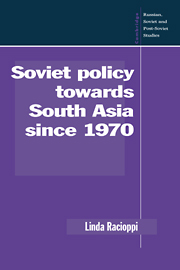Book contents
- Frontmatter
- Contents
- List of tables
- Acknowledgments
- 1 Introduction: South Asia in the USSR's Third World policy
- 2 Soviet perceptions of the Third World and South Asia
- 3 The Soviet Union in South Asia: objectives and instruments
- 4 Stability and change in Soviet–South Asian relations, 1970–1978
- 5 Soviet–South Asian relations in the wake of Afghanistan, 1978–1985
- 6 Soviet Policy towards South Asia in the Gorbachev era
- 7 Conclusion
- Notes
- Index
- Soviet and East European Studies
3 - The Soviet Union in South Asia: objectives and instruments
Published online by Cambridge University Press: 15 December 2009
- Frontmatter
- Contents
- List of tables
- Acknowledgments
- 1 Introduction: South Asia in the USSR's Third World policy
- 2 Soviet perceptions of the Third World and South Asia
- 3 The Soviet Union in South Asia: objectives and instruments
- 4 Stability and change in Soviet–South Asian relations, 1970–1978
- 5 Soviet–South Asian relations in the wake of Afghanistan, 1978–1985
- 6 Soviet Policy towards South Asia in the Gorbachev era
- 7 Conclusion
- Notes
- Index
- Soviet and East European Studies
Summary
Soviet views of the international environment, the Third World and South Asia, as articulated in the scholarly literature, became increasingly sophisticated in the 1970s and 1980s. Soviet analysts became more aware of the difficulties facing Third World states in completing the second phase of national liberation, freedom from economic dependence, and in undertaking a socialist path of development. The Soviet leadership was also painfully aware that it could not finance Third World development. Until the mid-1980s, however, political rhetoric and scholarly analysis continued to hold to the view of the inevitability of socialist transformation. Policy objectives for South Asia reflected the ambiguity in Soviet thinking about the Third World. On the one hand, there was recognition of limited Soviet capabilities, particularly in the economic sphere, and limited prospects for socialist transformation in the developing countries. On the other hand, there was the continued need to combat imperialism in order to promote socialism's development, first in the USSR and its East European allies, and second, globally. Political objectives then continued to reflect correlation of forces thinking and a somewhat dampened optimism about the prospects for the socialist transition in the Third World; that thinking was tempered by the realities of conditions in the Soviet Union and South Asia.
- Type
- Chapter
- Information
- Soviet Policy towards South Asia since 1970 , pp. 39 - 70Publisher: Cambridge University PressPrint publication year: 1994



